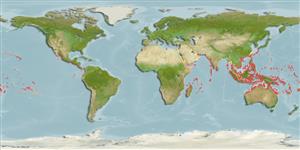Actinopterygii (ray-finned fishes) >
Perciformes (Perch-likes) >
Haemulidae (Grunts) > Plectorhinchinae
Etymology: Plectorhinchus: Greek, plektos = plaited + Greek, rhyngchos = snout (Ref. 45335).
Environment / Climate / Range
Ecology
Marine; freshwater; brackish; reef-associated; depth range 8 - 25 m (Ref. 58652). Tropical, preferred ?; 30°N - 24°S
Indo-West Pacific: Red Sea to Natal, South Africa (including Madagascar and the Comoro and Reunion islands); Gulf of Aden and the Persian Gulf eastward to Samoa, north to the Ryukyu Islands, south to Australia; Caroline and Mariana islands in Micronesia.
Size / Weight / Age
Maturity: Lm ? range ? - ? cm
Max length : 75.0 cm TL male/unsexed; (Ref. 30874)
Found in coastal reefs, sandbanks, and near estuaries (Ref. 30573). Enter freshwater (Ref. 7050). Small juveniles occur along sheltered sandy shorelines where they mimic a dead leaf by drifting on their sides (Ref. 37816). Adults mainly in protected inshore reefs to deep offshore, sometimes swims in small groups (Ref. 48635). Excellent food fish (Ref. 2799).
Life cycle and mating behavior
Maturity | Reproduction | Spawning | Eggs | Fecundity | Larvae
Oviparous, distinct pairing during breeding (Ref. 205).
Myers, R.F., 1991. Micronesian reef fishes. Second Ed. Coral Graphics, Barrigada, Guam. 298 p. (Ref. 1602)
IUCN Red List Status (Ref. 115185)
CITES (Ref. 94142)
Not Evaluated
Threat to humans
Reports of ciguatera poisoning (Ref. 2799)
Human uses
Fisheries: commercial; gamefish: yes
More information
ReferencesAquacultureAquaculture profileStrainsGeneticsAllele frequenciesHeritabilityDiseasesProcessingMass conversion
Tools
Special reports
Download XML
Internet sources
